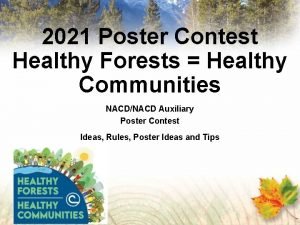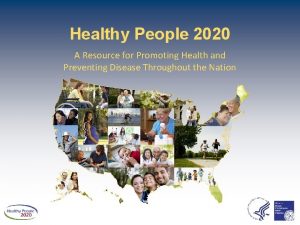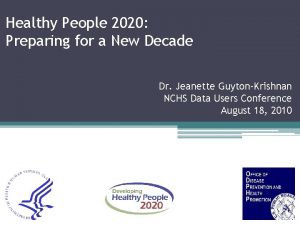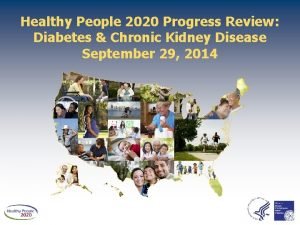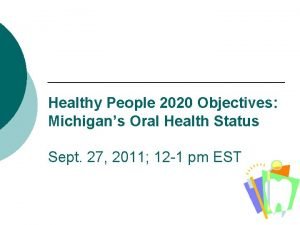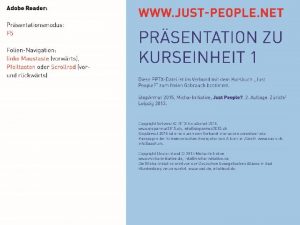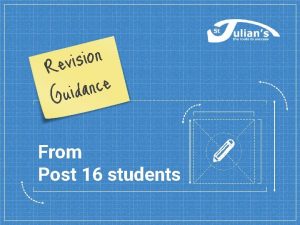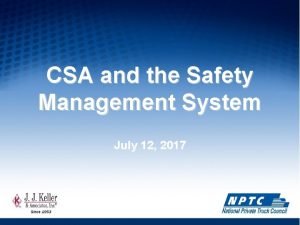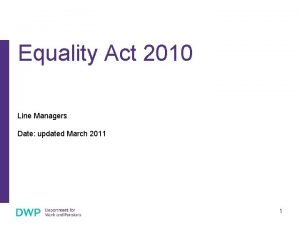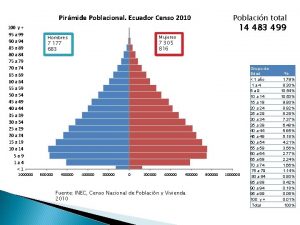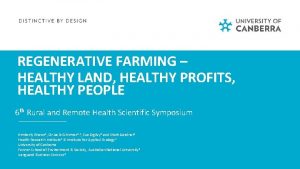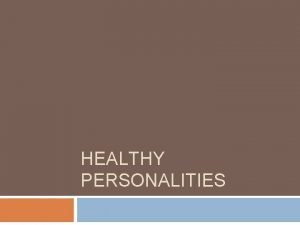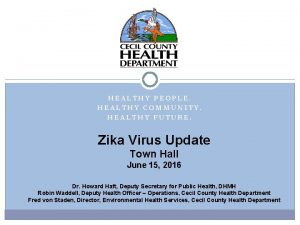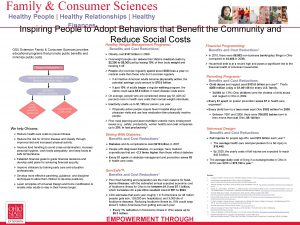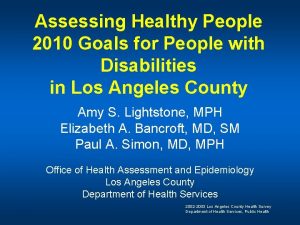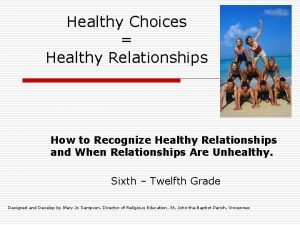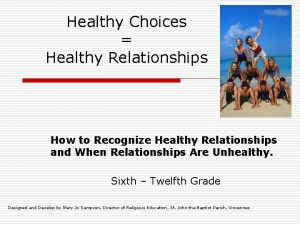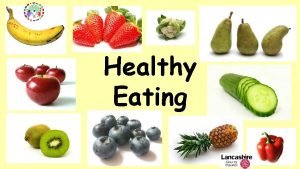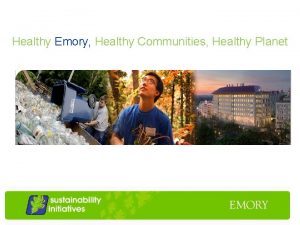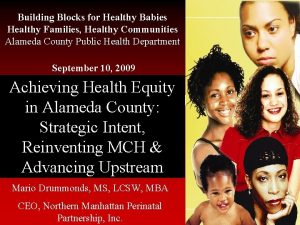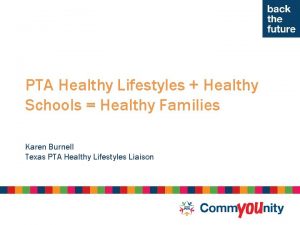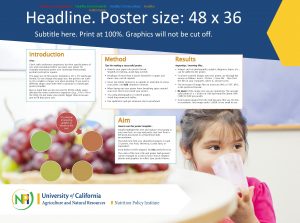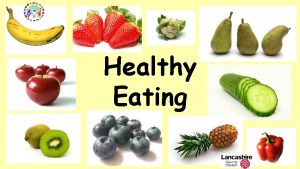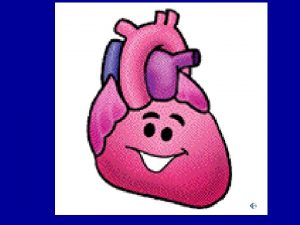What is Healthy People 2010 Healthy People is




















- Slides: 20

What is Healthy People 2010? Healthy People is a national health promotion and disease prevention initiative to improve the health of all Americans, eliminate disparities in health, and improve years and quality of healthy life. It is a statement of national health objectives designed to identify the most significant preventable threats to health and to establish national goals to reduce these threats.

Goal 1 Increase Quality and Years of Healthy Life The first goal of Healthy People 2010 is to help individuals of all ages increase life expectancy and improve their quality of life.

Goal 2: Eliminate Health Disparities The second goal of Healthy People 2010 is to eliminate health disparities among different segments of the population.

Healthy People 2010: Overall Substance Abuse Goal Reduce substance abuse and thereby protect the health, safety, and quality of life of all Americans, especially the Nation’s children.

Why Do We Need A Goal? Substance abuse and substance abuse-related problems are among society’s most pervasive health and social concerns. Some 100, 000 people die each year in the United. States as a result of alcohol alone. It costs every man, woman, and child in America nearly $1, 000 annually to cover the costs of health care, law enforcement, motor vehicle crashes, crime, and lost productivity due to substance abuse

Surveys and Databases • Provide a State and National Picture • Allow us to track trends in drug use • Allow us to determine if our prevention programs are working • Can be used as a needs assessment • Are conducted by a variety of governmental offices (CDC, NIH, NIDA)

Major Surveys • Youth Risk Behavior Surveillance Survey • National College Health Risk Behavior Surveillance Survey • National Household Survey on Drug Abuse • Monitoring The Future

Problems With Surveys • • • Don’t all access serious drug users Self-report Questions design Frequency of Data Collection Quantitative Vs Qualitative data collection methods

Drug Education: What have we done in the past? • Lack of Information Theory • Scare Tactics – “This is your brain on drugs” • Personality Deficits – Focus in the individual and what they were lacking. – “Blaming the victim”

Risk Factors • Belief was the certain factors can put young people at risk of beginning substance use. • These factors include: – Individual Factors – School Factors – Peer Factors – Family Factors – Community Factors

Hawkins, Catalano, & Miller Risk Factors: Contextualsocial contexts that place the individual at greater risk of substance abuse Individual and Interpersonalcharacteristics of the individual and their personal environment that put them at greater risk of substance abuse

Protective Factors • Protective factors are factors that lesson the risk of substance use. These include: – Positive Social Bonding – Sense of Attachment – Sense of Commitment – Sense of Values

Change in Drug Prevention Planning Risk Factors Problem Focus Resiliency Solution Focus

Shifting the balance or tipping the scales from vulnerability to resilience may happen as a result of one person or opportunity.

Resiliency: Resiliency is the process of coping with disruptive, stressful or challenging life events in a way that provides the individual with additional protective and coping skills prior to the disruption that resulted from the event. Richardson, Neiger, Jensen, and Kumpher (1990)

Resiliency • First resiliency studies followed children who were growing up in high risk situations to determine if they developed a problems. – Poverty – Alcoholic families – Neglect – Child abuse

Profile of the Resilient Child • • Individual Factors Social Competence Problem-solving skills Autonomy Sense of Purpose and

Profile of the Resilient Child Family • Caring and Support • High Expectations • Encourage Children’s Participation

Profile of the Resilient Child School • Caring and Support • High Expectations • Youth Participation and Involvement

Profile of the Resilient Child Community • Caring and Support • High Expectations • Opportunities For Participation
 Healthy forests healthy communities poster contest
Healthy forests healthy communities poster contest Healthy nurse healthy nation
Healthy nurse healthy nation Nutrition and productivity
Nutrition and productivity Healthy soil healthy life poster ideas
Healthy soil healthy life poster ideas Healthy people 2020 goals
Healthy people 2020 goals Healthy people 2020 goals
Healthy people 2020 goals Healthy people 2020 diabetes
Healthy people 2020 diabetes Healthy people 2020 goals
Healthy people 2020 goals People killin people dying
People killin people dying Recovery community
Recovery community People just people
People just people Sample of people in media
Sample of people in media Rezultate evaluare nationala 2010
Rezultate evaluare nationala 2010 How many basics are scored under csa
How many basics are scored under csa Bbxnxn
Bbxnxn Small business server 2010
Small business server 2010 Equality act 2010
Equality act 2010 2010 pearson education inc answers
2010 pearson education inc answers Censo de poblacion 2010
Censo de poblacion 2010 Undang undang nomor 9 tahun 2010
Undang undang nomor 9 tahun 2010 Maria emília miranda
Maria emília miranda
